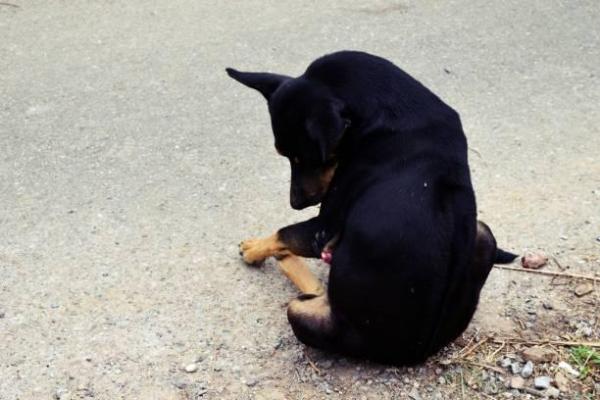My Dog's Penis Is Stuck Out



See files for Dogs
When a dog's penis sticks out, it is very noticeable. After emerging from the penile sheath (or foreskin), the hairless penis is striking due to its color. It is usually a bright red color due to the large amount of blood entering the penile tissue. Some dog guardians liken this to a lipstick emerging from its tube. A normal dog erection can cause this to happen, but it can be a little shocking to some people when it is first seen. In the majority of circumstances, it is a natural response which should cause no concern. However, if the dog's penis won't go back in or it is accompanied by other symptoms, it could be a sign of a problem.
At AnimalWised, we find out why my dog's penis is stuck out. We look at the possible penile health problems which can lead to the dog penis sticking out and not going back in such as priapism, paraphimosis or an infection.
Sexual arousal
Sexual arousal in male dogs is necessary for the mating act. If a sexually mature male has not been castrated, erections are a common reason why a dog's penis is stuck out. While they may be aroused for some time, it will eventually recede. It may stay out longer if there is a female in heat nearby, but they are unable to mate with them. In these cases, you will often see the dog lick their penis to try to relieve sexual frustration.
Although it will happen much less, it is also possible for a neutered dog to achieve an erection. This could be due to residual hormones since testosterone is also produced in the adrenal glands, although to a much lesser extent than the testicles. It could also be a result of non-sexual excitement which might result in an erection response.
In these cases of excitement, the dog may see a new person enter the home, smell something which arouses them or even has a play session which leads to this state. It should not cause the dog to be excited for long periods, especially if they have been castrated. Unfortunately, stress is also a type of excitement which can lead to the dog's penis sticking out.
Especially if a neutered dog has been castrated after they have reached sexual maturity, erections can be more likely. This may be due to the dog humping objects or even other dogs as a learned behavior. The physical stimulation which occurs may be enough to cause an erection.
What to do if a dog is excited
A dog's penis may stick out as a sign of excitement, whether sexual or otherwise. If it returns to the prepuce without any problem, you do not need to do anything in the moment. However, reproductive behaviors in dogs can be problematic in general. Not only do they lead to unwanted dog pregnancies, but they can cause the dog to behave inappropriately in the home.
Neutering a male dog provides many benefits. It reduces the risks of various behavioral problems such as escapism. In addition to preventing pregnancy, it provides various health benefits to the dog since the removal of the testicles reduces diseases associated with these sex organs.
If the dog's penis is stuck out and won't go back in, this is a different matter. We discover some of the possible reasons for this symptom in the sections below.
Infection
When a dog's penis sticks out of its foreskin, it is red in color. As we have previously mentioned, this is due to the large amount of blood running to the vessels in the penile tissue. This allows the stiffness necessary for copulation, especially when the dogs stick together while mating. However, if we see our dog's penis is red, swollen and inflamed without being erect, this indicates an infection.
Such inflammation of the penis can be a sign the dog suffers from balanoposthitis, an inflammation of the foreskin and glans penis. As with relieving sexual frustration, the dog usually licks the area excessively to reduce the irritation caused by the infection. They may try to scratch the area. This can lead to secondary bacterial infection. Both primary and secondary infections can also cause pus and a foul odor to develop.
The problem of balanoposthitis is quite common in male dogs and usually appears as a result of the proliferation of opportunistic bacteria. These are found naturally in the penis area of our canine companions, but when they multiply to a large number, an infection occurs. This can be exacerbated by issues such as the dog having a lowered immunity due to another disease or health issue.
Treatment of balanoposthitis in dogs
The treatment of canine balanoposthitis consists of administering effective antibiotic treatment for about 3 or 4 weeks. Diagnosis will be based on bacterial culture and an antibiogram to determine the type of bacteria which needs to be controlled.
In addition to antibiotic treatment, it is essential to clean or wash the area with diluted antiseptic solutions. It is recommended you use something safe such as chlorhexidine for dogs. A topical broad-spectrum antibiotic cream may also be helpful. It is important to prevent the affected dog from licking the area, for which the use of an Elizabethan collar is recommended.

Paraphimosis
Paraphimosis occurs when a dog cannot retract the penis into the foreskin sheath. In this case, the penis is stuck out and won't go back in. This happens especially in young dogs after copulation, masturbation or some trauma to the area. The penis appears engorged and somewhat discolored to the naked eye. If it remains exposed over time, the dog will begin to lick itself and more serious injuries may occur. It can even lead to necrosis of the penis tissue.
Treatment of paraphimosis in dogs
Treatment of paraphimosis in dogs consists of measures to attempt to return the penis to the prepuce (foreskin). This can be done using lubricants, local cold therapy or hyperosmotic solutions while pushing the foreskin forward.
If this fails, surgical enlargement of the preputial orifice must be performed temporarily or permanently through a procedure called prepuciotomy. This operation is performed with the dog in dorsal recumbency, making an incision through the thickness of the skin of the foreskin, the subcutaneous tissue and the preputial mucosa in the median raphe of the dorsal surface of the same. The penis is then reintroduced and the incision is closed carefully in three layers.

Priapism
The last reason why a dog's penis is stuck out and won't go back in is a condition known as priapism. Priapism consists of the permanent erection of a dog's penis not associated with sexual arousal, making urination difficult and predisposing the penis to be permanently damaged. This tissue damage is caused by desiccation and ischemic necrosis.
In the initial stages of priapism in dogs, the penis can be manually reintroduced into the foreskin. This differentiates it from paraphimosis since the reintroduction of the penis is not achieved in the latter.
Priapism will be sore and uncomfortable due to the perpetual erection in the dog and limited blood flow. The causes are varied and may appear as a consequence of lesions in the cauda equina, viral diseases, use of tranquilizers, metastasis of some tumors, perineal trauma, bladder damage or any spinal injury that occurs with parasympathetic stimulation of the pelvic nerve.
Treatment of priapism in dogs
Therapy for priapism in dogs must be seen as urgent, since the vascularization of the penis may be compromised. This not only causes dogs to experience a lot of pain, but it puts the integrity of their member at risk. In addition to cleaning and disinfecting the dog's penis, an attempt should be made to correct the problem using a puncture to evacuate the corpora cavernosa or injections of adrenergic agonists. If this does not work or the damage is irreparable, the only solution is to perform a penile amputation and a perineal urethrostomy.
If you see your dog's penis won't go back in or is stuck for prolonged periods, you will need to speak to a veterinarian. They will be able to assess the dog to provide the correct diagnosis and treatment. Learn more about the reasons why a dog has a swollen penis with our related article.

This article is purely informative. AnimalWised does not have the authority to prescribe any veterinary treatment or create a diagnosis. We invite you to take your pet to the veterinarian if they are suffering from any condition or pain.
If you want to read similar articles to My Dog's Penis Is Stuck Out, we recommend you visit our Other health problems category.
- García, L. (2024). Priapism in dogs, causes and treatment. https://www.expertoanimal.com/priapismo-en-perros-causas-y-tratamiento-26863.html
- Square, N., García, E., & González, S. (2004). Anomalies of the dog's reproductive system.
https://www.uco.es/organiza/departamentos/anatomia-y-anat-patologica/peques/curso01_05/ap_reproduc2004.pdf







